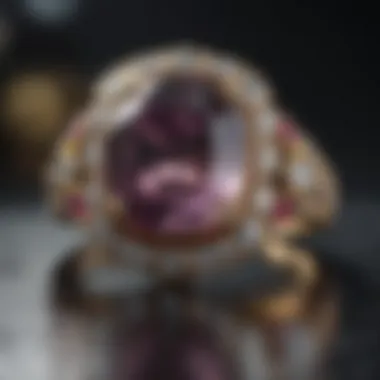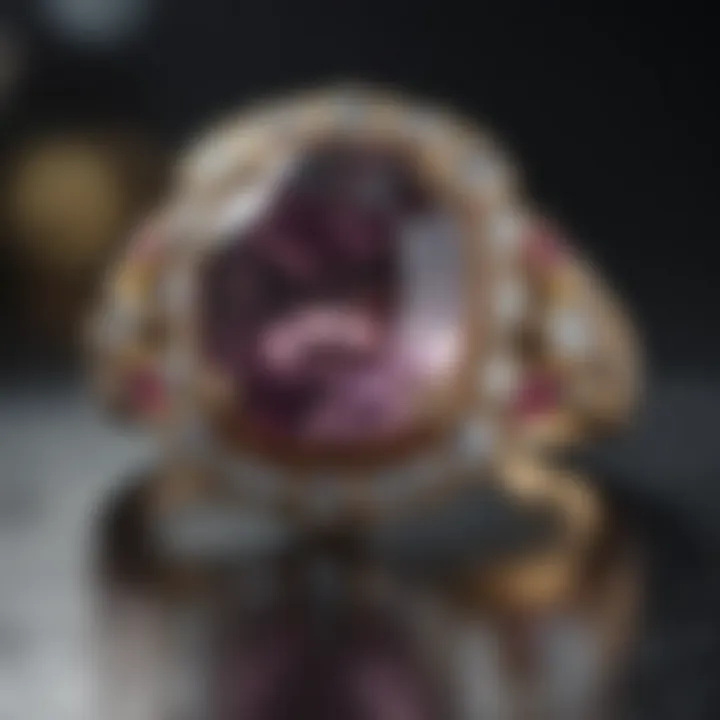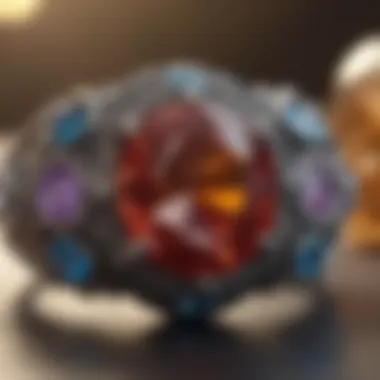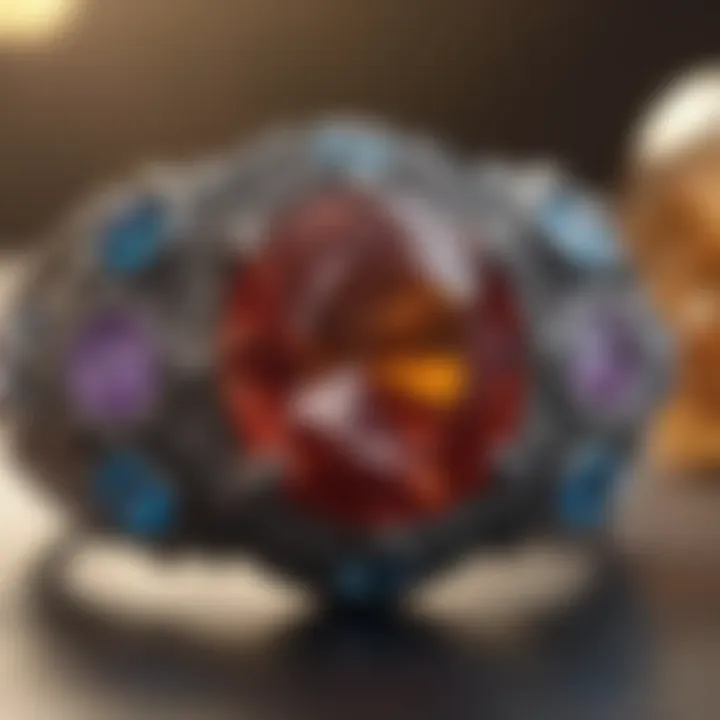Understanding Payment Methods for Engagement Rings


Intro
Engagement rings are more than just jewelry; they symbolize love and commitment. Understanding how to pay for such an important item is crucial for many buyers, whether they are purchasing for the first time or the tenth. Diverse payment methods exist, ranging from traditional to innovative.
This article explores the various ways to finance and purchase engagement rings. We will discuss budgeting strategies, financing plans, and the cultural contexts that influence how much people spend on these rings. Understanding these aspects will equip buyers with knowledge for making better decisions.
Gemstone Overview
Definition of Gemstones
Gemstones are precious or semi-precious stones that are used in jewelry. These stones are valued for their beauty, rarity, and durability. While diamonds dominate the engagement ring market, other stones such as sapphires, emeralds, and rubies also hold significant appeal.
Classification of Gemstones
Gemstones can be classified into several categories:
- Precious Stones: This group includes diamonds, rubies, sapphires, and emeralds. They are typically rarer and command higher prices.
- Semi-Precious Stones: These include amethyst, garnet, and aquamarine, among others. While not as expensive as precious stones, they still have their own unique appeal.
- Organic Gemstones: These are created from living organisms, such as pearls and coral.
Different classifications lead to varied costs and perceptions, which ultimately influence consumer decisions. Understanding the types can help buyers select the right ring within their budget.
Historical Significance
Origins of Gemstone Use
The use of gemstones in jewelry dates back thousands of years. Various cultures have attributed specific meanings and powers to different stones. Diamonds were once believed to protect warriors in battle, while sapphires signified wealth and wisdom.
Cultural Insights: Gemstones in Ancient Civilizations
In ancient civilizations, gemstones often held great significance. For example, the Egyptians valued turquoise and carnelian, believing they provided protection and good fortune. Similarly, in ancient Greece, gemstones were associated with mythological figures, enhancing their allure.
Understanding the historical context of gemstones adds depth to their purchase. Buyers often feel joy when they connect to the long-standing traditions and meanings tied to the stones they choose.
Preface to Engagement Rings
The journey to purchasing an engagement ring is often filled with emotional significance and comprehensive considerations. Understanding engagement rings can greatly aid individuals in navigating the complex landscape of payments, styles, and symbolic meanings attached to these pieces of jewelry. In this section, we examine important elements of engagement rings and why they hold a notable place in the realm of commitment and love.
Significance of Engagement Rings
Engagement rings signify commitment and the promise of a shared future. They are not mere adornments but rather powerful symbols of love. When one chooses an engagement ring, they engage with various factors, including personal tastes, budget, and cultural expectations.
The emotional weight of the ring often adds layers of meaning. Some couples opt for traditional styles, while others may choose unique designs that reflect their shared experiences. Regardless of the choice, the ring represents a pivotal moment in a relationship.
Historical Context
Engagement rings have a storied history that stretches back centuries. In ancient Rome, the tradition of giving a ring to signify engagement began. These rings often consisted of simple materials like iron but symbolized strength and unity.
As time progressed, diamonds became a more popular choice in the 19th century, evolving from mere tokens to the centerpieces we recognize today. The marketing by companies like De Beers popularized diamonds as the ultimate symbol of undying love in the 20th century, leading to the adage that a diamond is forever. This historical evolution illustrates how societal values and marketing strategies significantly influenced consumer perceptions.
In today's context, the choice of an engagement ring embraces both cultural significance and personal aesthetics, representing the unique bond shared by couples.
Traditional Payment Methods
Traditional payment methods remain a cornerstone in finance practices associated with engagement ring purchases. Understanding these methods can help buyers navigate their options with greater confidence and make informed decisions. Each traditional method carries its unique pros and cons that buyers must consider. Moreover, these choices can significantly affect the total cost, potential debt, and personal satisfaction associated with the purchase.
Cash Transactions
Cash transactions are the most straightforward method of payment when purchasing an engagement ring. Many jewelers also prefer cash due to the immediacy and lack of processing fees typically associated with credit cards or financing plans.
The benefits of cash transactions include:


- No Interest or Fees: Paying in cash eliminates the concerns of accumulating debt. There are no hidden costs related to interest rates or service fees that often come with credit purchases.
- Bargaining Power: Buyers can often negotiate better prices when offering cash. Jewelers appreciate instant payment, which can be a significant advantage during discussions about pricing.
- Immediate Ownership: With cash transactions, buyers receive the item immediately after payment without needing to wait for approval from a financing entity.
However, cash transactions can have drawbacks too. For instance, carrying large sums of cash can create a security risk. Furthermore, buyers may inadvertently overshoot their budget without detailed planning, utilizing available savings rather than credit responsibly.
Credit Card Purchases
Credit cards offer a flexible payment option for many buyers seeking engagement rings. This method provides various benefits, but also potential risks.
Some advantages include:
- Rewards Programs: Many credit cards offer rewards points for transactions. This can lead to significant savings or perks on future purchases.
- Consumer Protection: Credit cards often provide better protection against fraud. Purchases can be disputed if there are issues with the ring, allowing buyers to feel more secure.
- Financing Options: Certain cards come with promotional interest rates or deferred payments, which can make expensive purchases manageable over time.
On the downside, buyers should consider:
- Interest Rates: If the balance is not paid off quickly, high interest rates can turn an affordable purchase into a significant financial burden.
- Spending Temptation: Credit may lead to overextending one's budget. It's easy to rely on available credit, resulting in regrettable financial decisions.
Layaway Plans
Layaway plans present a unique method of purchasing without immediately paying the full amount upfront. With this option, shoppers can make small payments over time until the total is paid.
The benefits of layaway include:
- Budget Control: This method allows buyers to prioritize their spending. They can save for the ring while avoiding debt, paying only what they can manage.
- Product Reservation: By committing to layaway, buyers secure their chosen ring, protecting it from being sold to another customer before they can make the full payment.
- No Interest Fees: Layaway plans typically do not involve interest, ensuring that the total cost of the ring stays within budget.
Nonetheless, limitations persist with layaway plans:
- Time Constraints: Buyers may risk losing their investment if they cannot complete payments within a given timeframe. Missing deadlines can lead to forfeiture of funded amounts.
- Limited Selection: Many retailers restrict layaway to specific products or amounts, which could result in missed opportunities on preferred rings.
In summary, each traditional payment method offers distinct features to consider for any engagement ring purchase. Buyers should evaluate their finances and preferences carefully to select the best approach.
Financing Options
Financing options play a crucial role in the process of purchasing an engagement ring. For many, this significant jewelry purchase represents a major financial commitment. Therefore, understanding how to finance it can ease the burden of the one-time payment. Financing options help individuals find a suitable method to match their financial capabilities and preferences. They provide flexibility in payment structures, allowing buyers to manage their budgets without stress. Moreover, financing options can open doors to higher quality stones or unique designs that may have been previously financially unfeasible.
Store Financing Plans
Store financing plans are increasingly offered by retailers to assist consumers in acquiring their desired engagement ring. These plans typically involve in-house financing arrangements which emit a sense of convenience and immediacy. Many jewelers provide promotional periods with low or zero interest rates if consumers complete payments within a specified timeframe. This incentive allows buyers to enjoy their choice while spreading the cost over months.
However, it's important to consider the terms and conditions of these plans. Often, there may be hidden fees, or high-interest rates can apply if the balance is not cleared in time. Buyers need to thoroughly review these documents before committing.
Personal Loans
Personal loans are another viable option for financing an engagement ring. They typically offer larger amounts than store financing, which provides the chance to purchase a ring with potentially higher quality. These loans can be secured from various sources, including banks, credit unions, or online lenders.
The application process usually requires a credit check, and terms can vary based on the borrower's credit score. The important aspect of personal loans is that they offer fixed repayment schedules, making budgeting a more manageable task. However, interest rates on personal loans can be higher than those for store financing plans, depending on creditworthiness.
Buy Now, Pay Later Services
Buy Now, Pay Later (BNPL) services have gained tremendous popularity in recent years. They allow consumers to make a purchase immediately while paying it off in installments over time. These services often come with minimal interest charged, or sometimes none at all if payments are completed on time.
Providers like Klarna or Afterpay facilitate this process, making it easier for buyers to acquire the ring they desire without the immediate financial strain. However, caution is advised. Unforeseen financial circumstances can affect one's ability to adhere to the payment schedule. Failure to pay can lead to accumulating fees that negate the initial benefits of using BNPL services.
Overall, assessing various financing options can empower consumers to make informed decisions about engagement ring purchases. Each option has its pros and cons, and understanding these can lead to successful financial planning.
Peer-to-Peer Payment Platforms
The rise of technology has transformed traditional payment methods, making peer-to-peer payment platforms increasingly important in the world of engagement ring purchases. These platforms offer unique advantages, allowing individuals to send and receive money quickly and easily. In this section, we will explore the specific elements, benefits, and considerations related to peer-to-peer payment platforms in the context of buying engagement rings.
Using Apps for Transactions


Applications such as Venmo, PayPal, and Cash App have gained widespread popularity as convenient tools for financial transactions. These apps simplify the process of transferring funds between friends, family, and even between buyers and sellers for engagement rings. This is especially beneficial for those who prefer not to carry cash or use credit cards.
Using these apps can enhance your purchasing experience because of their accessibility and ease of use. with just a few taps on your smartphone, you can send money instantly to a jeweler or receive funds for a group gift. However, transferring large sums may attract additional fees, depending on the platform and transaction type.
Another benefit of these apps is their integration with social networks. As the platforms grow, users can easily share their purchases or request payments within familiar environments. Still, it is wise to understand the fees associated with each app and verify that the jeweler accepts payments through these platforms.
Social Influence on Payment Choices
Social influence plays a significant role in shaping how individuals make payment choices. In today's digital age, peer pressure and expectations can impact decisions. Many individuals take cues from friends and family about how much to spend on an engagement ring. This often leads to choices guided by societal norms rather than personal finances. When people observe their peers using apps for transactions, it may prompt them to adopt similar practices.
Furthermore, platforms that allow users to share their purchases can create a communal sense of validation. When someone showcases their engagement ring purchase on social media, it may encourage others to consider using the same payment options.
Impact of Culture on Spending Habits
Understanding the impact of culture on spending habits is crucial when discussing engagement rings. Cultural norms and values influence how individuals perceive the significance of jewelry, and, specifically, engagement rings. In many cultures, the engagement ring is not just a piece of jewelry; it embodies love, commitment, and societal expectations. This societal pressure shapes purchasing behaviors and the financial decisions that couples make.
Cultural expectations can dictate the type of ring that is deemed appropriate, which can vary significantly across different regions. Some cultures may emphasize the quality and carat weight of the diamond, while others prioritize the ring's design or meanings associated with specific gemstones. Understanding these nuances can help buyers navigate their options more effectively and align their purchases with cultural significance.
Additionally, cultural traditions often dictate whether a couple should spend a certain percentage of their income on an engagement ring. Some cultures may suggest spending two or three months' salary, while others may take a more relaxed approach. This influences the buyer's budgeting and financial planning efforts when selecting a ring.
"Cultural norms shape perceptions of value and significance, influencing not only how much one spends but what is considered a suitable engagement ring."
Cultural Expectations
Cultural expectations form a foundation on which individuals build their engagement ring purchases. In many Western cultures, an engagement ring often features a diamond, symbolizing fidelity and love. This association has developed over decades, influenced heavily by marketing and media. Conversely, in other cultures, different stones may hold more significance. For example, in some Asian cultures, colored sapphires or rubies might be favored for their unique meanings.
These cultural preferences can impose certain expectations on individuals and couples. Buyers often feel pressure to conform to established norms. Failure to meet these expectations may lead to social judgment or feelings of inadequacy. Therefore, understanding cultural context is essential for a fulfilling purchasing experience that honors both personal choice and societal standards.
Variances in Global Practices
Global practices regarding engagement ring purchases differ widely, reflecting the diversity of cultural influences. In some countries, such as India, tradition underscores the engagement process with the exchange of rings viewed less as a public declaration and more as a private commitment. Rings may not play as central a role in the engagement ceremony, and materials used can range from gold to silver or even functional jewelry rather than symbolic pieces.
In other cultures, notably in parts of Europe, the practice of ring exchange might be preceded by more ceremonial gestures, such as family blessings or elaborate engagement parties. Furthermore, the materials of choice may shift, with custom and artisanal pieces gaining traction over mass-produced options.
In North America and Western countries, the diamond-centric approach is dominant, fueled by historical advertising campaigns, where the diamond represents the peak of romantic ideals. However, there is a growing trend towards sustainable and ethically sourced gemstones globally, reflecting a shift in values across consumer bases.
These variances illustrate that purchasing practices are not merely personal but are also significantly shaped by cultural narratives and expectations. Understanding these global practices provides insight into how different communities cherish and celebrate engagement, affecting financial decisions and choices made in the pursuit of the perfect ring.
This section denotes the cultural dimensions that significantly shape the way individuals perceive and interact with the market for engagement rings. The complexities behind these choices highlight the need for awareness not only from a purchasing standpoint but also from a relational and societal perspective.
Psychological Factors Behind Payment Decisions
Understanding how psychological factors influence payment decisions is crucial for potential buyers of engagement rings. This section sheds light on why these factors play an essential role in the purchasing process. Many individuals do not realize they are influenced by emotions and perceptions when making significant investments like engagement rings. Recognizing these elements can lead to more informed and satisfying choices.
Emotional Connection to Jewelry
The emotional connection people have to jewelry, especially engagement rings, is profound. For many, the act of choosing a ring is not just about finding the perfect piece, it symbolizes commitment, love, and personal history.
- Sentimental Value: An engagement ring is often seen as a representation of a couple’s journey. This sentimental tie can elevate a ring beyond mere material value.
- Cultural Associations: Different cultures have varying values placed on rings, further amplifying the emotional stakes involved. Some cultures see the ring as a badge of honor, while others see it as a sacred bond.
- Personal Stories: Many buyers find joy in the narrative behind the ring. Whether it's an heirloom passed down through generations or a contemporary design that embodies their love story, stories shape the emotional weight of the piece.
As a result, this connection affects how much a buyer is willing to spend. The deeper the emotional connection, the more likely a person is to prioritize this purchase in their financial planning.
Perceived Value vs. Actual Cost
Another pivotal psychological factor is the perception of value compared to the actual cost of the ring.
- Value Perception: Buyers often equate price with quality. They may perceive a higher price tag as a sign of better craftsmanship or uniqueness, which drives them to spend more than they initially planned.
- Social Pressure: Influencers and social media play a significant role in shaping perceived value. Couples often compare themselves to others. This can lead to an inclination to spend more, trying to keep up with expectations set by peers.
- Marketing Influences: Jewelers often employ strategic marketing techniques, such as emphasizing rarity and exclusivity, manipulating how potential buyers view costs. This marketing can create an inflated sense of what value should be, distorting decision-making processes.
Thus, being aware of the difference between perceived value and actual cost is essential. This clarity can help buyers make wiser financial decisions when selecting an engagement ring.


"Understanding the psychology behind your spending can empower you to make more informed choices and prevent emotional overspending."
Budgeting for the Engagement Ring
Budgeting is a fundamental aspect of the engagement ring buying process. Proper financial planning allows buyers to make informed choices without overspending or compromising their desires. A well-thought-out budget can lead to a satisfying purchase experience without the burden of debt. For many, an engagement ring symbolizes love and commitment. Thus, it deserves careful consideration in its financial planning.
Establishing a Realistic Budget
Setting a practical budget refrains from lofty ideals and focuses on what is financially feasible. Begin by assessing your current financial situation. Consider factors like income, savings, and necessary expenses. Knowing your limits is crucial. It’s also wise to factor in possible extra costs like taxes or insurance, which can affect the overall expense. A budget should be more than just a number; it serves as a guiding framework throughout the selection process.
Additionally, it is beneficial to discuss budgets openly with your partner, if applicable. This could lead to better understanding and alignment between both parties regarding financial priorities and expectations. Tools like budgeting apps can help keep track of expenses and ensure that you stay within limits.
"A clear budget not only removes anxiety but also transforms a daunting purchase into an enjoyable experience."
Factors to Consider in Budgeting
When budgeting for an engagement ring, several considerations come into play. Here are some critical factors:
- Quality of the Ring: The quality of the materials will heavily impact the price. Consider the kind of metal and gem involved. For instance, platinum will generally be pricier than gold.
- Circumstantial Flexibility: Life events like job changes or family commitments can require a reassessment of your budget. Stay adaptable to these changing circumstances.
- Additional Expenses: Anticipate other potential expenditures such as ring resizing, warranties, or inscriptions. These costs can accumulate.
- Market Trends: Diamond and gemstone prices fluctuate regularly. Being aware of market conditions might assist in finding the right moment to make a purchase.
- Long-term Financial Goals: Keep your long-term finances in mind. This should include savings for future needs like a house or family.
Balancing desires with financial realities is essential. By adhering to these guidelines, prospective buyers can ensure a more fulfilling engagement ring purchase.
Emerging Trends in Ring Purchases
The landscape of engagement ring purchases is changing. Emerging trends reflect shifts in consumer attitudes, values, and preferences. Understanding these trends is essential for both buyers and sellers. It creates opportunities for personal expression while also allowing jewelers to align with consumer values. This section will delve into two significant trends: customization and personalization; and sustainable and ethical sourcing.
Customization and Personalization
Customization of engagement rings is becoming increasingly popular. Many people want a ring that reflects the unique bond they share. This desire extends beyond just the choice of stone or metal. It includes design elements like engraving or using non-traditional shapes.
This trend provides several benefits:
- Emotional Connection: A customized ring often carries more meaning, as it reflects the couple's story and individuality.
- Uniqueness: Personalization sets the ring apart from standard offerings in stores, making it a one-of-a-kind piece.
- Budget Flexibility: Custom options allow buyers to adjust their choices based on budget, opting for unique designs while managing financial constraints.
However, there are some considerations to keep in mind. The timeline for creating a custom piece can vary, often requiring more time than selecting from existing inventory. Buyers should factor in this time commitment when planning their purchase.
Sustainable and Ethical Sourcing
Sustainability is another critical trend gaining traction in the jewelry market. Buyers are increasingly aware of where their materials come from. They seek rings made from ethically sourced gemstones and environmentally friendly materials. This reflects a growing consciousness about the impact of mining and production processes.
Benefits of sustainable sourcing include:
- Ethical Responsibility: Purchasing from suppliers focused on ethical practices can negate the negative impacts of traditional mining.
- Transparency: Many jewelers offer information about the origins of their materials, creating trust with consumers.
- Connection to Community: Some sources involve local communities in their mining processes, fostering economic development in these regions.
Like customization, sustainable sourcing requires thoughtful consideration from buyers. Not all jewelers may have straightforward practices regarding sourcing. It is essential to research and verify the claims made by sellers.
"Selecting an engagement ring is not just a purchase. It's a statement about values—both personal and social."
Together, these trends illustrate a new direction in engagement ring purchases. They emphasize individuality and responsibility while adapting to changing consumer demands. Incorporating customization and sustainability in the buying process can create a richer experience for couples as they embark on their journey together.
End
Final Thoughts on Payment Methods
When it comes to selecting payment methods for engagement rings, several factors must be considered. This includes one’s budget, preferred purchasing experience, the significance of the ring, and even personal values surrounding financial commitments. Methods like layaway and buy now, pay later offer accessibility and flexibility for buyers who may not have the upfront cash available.
Moreover, peer-to-peer payment platforms have changed the landscape of transactions, making purchases easier and often more private. It is vital to recognize that while payment methods evolve, the emotional significance of the engagement ring remains steadfast. An informed decision can transcend mere monetary concerns, allowing buyers to focus on what truly matters—the commitment symbolized by the ring.
Future Perspectives on Engagement Ring Purchases
The future of engagement ring purchases will likely see continued innovation in payment methods and consumer preferences. As technology advances, we may witness an increase in cryptocurrency acceptance among jewelers. Furthermore, ethical and sustainable sourcing practices will continue to influence how rings are bought and sold, affecting payment methods as well.
Current trends indicate that more buyers prefer to personalize their purchase experience, seeking rings that reflect their values and identities. In this context, financing options may also adapt, with more personalized plans that cater to individual financial situations. The demand for transparency in pricing and ethical sourcing will likely reshape both the jewelry market and the payment landscape.
In summary, understanding the payment methods for engagement rings is not just about transactions; it is about aligning financial choices with emotional commitments. As preferences evolve, both buyers and sellers will navigate a landscape ripe with opportunities for innovation.



